
Google PageRank
簡介
簡易範例
鄉村與都市的人口遷移問題,給定鄉村初始占總人口的比例,都市則是。鄉村有的遷出率,都市有的遷出率,則第年的人口狀態可以表達為

若不考慮人口出生或死人,直覺上會覺得「無論起始值如何給定,只要時間夠長,最終一定會到收斂到平衡狀態。」即平衡狀態的存在性
與收斂性
現在將問題擴大成有座城市,初始的各城市人口占比為,並用一個轉移矩陣 (stochastic matrix) 表達遷移狀態,用表達從城市至城市的機率。則我們有
設為穩定狀態,則存在性問題即討論的 Eigenvector 是否存在,收斂性問題與起始點無關
那最終我們可以把問題想像成
每個都市都是一個頁面,人口比例就是人們點進去這個網站的機率。
Google Pagerank
PageRank簡稱PR,是Google對搜尋結果排名的其中一個演算法。其假設為
重要的頁面會被更多其他頁面參照。
可應用於「圖論的有向性地圖權重」問題,藉由機率分布體現「某人在某個頁面的機率」。用表示「某人停在頁面的機率,亦表示為頁面在集合內的權重」。若,則表示有0.3的機率出現在頁面。而所有的頁面PR值合為1。
簡化模型
假設
- 頁面不允許自我參照;
- 頁面至少參照一個頁面;
若參照情況如下
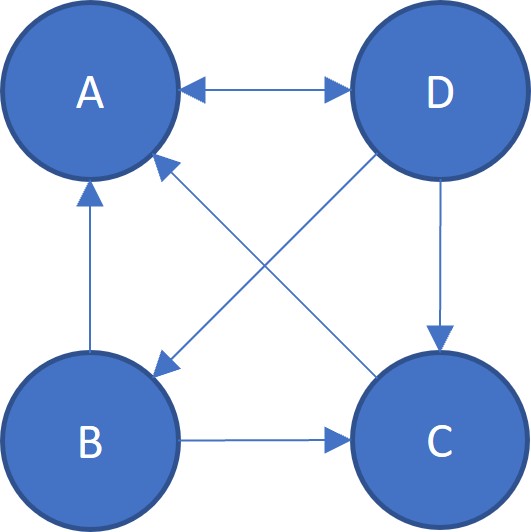
B頁面參照A與C頁面,即B給與A與C各票。同理,也能看出D給與A、B與C各票。故A獲得B的票、C的1票、與D的票。
同理
若有個頁面,設為有參照頁面的集合, 為頁面所參照的頁面數量,則任意頁面可以寫為
解非唯一
在簡化模型中,會出現PR值得解非唯一的情況,考慮以下參照狀態
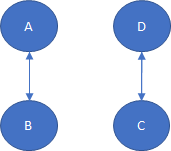
則顯然的
都能成為解,事實上
對任意 都能成為解。問題出在 ,即 Eigenspace 太大使得 的解非唯一。
完整模型
上述我們做了2項假設,其中的第2假設「頁面至少參照一個頁面」,若某頁面不參照其他任何頁面,則會導致該頁面的PR值像個黑洞一樣只進不出。為防止這個情況,做出以下設定「若某頁面不參照其他頁面,則視為參照其他所有頁面。」
給定一個,改變計算PR值的方式為
這邊的為阻尼係數(damping factor)視為隨機瀏覽者(random surfer)根據推送到下一個頁面的機率,而就視為隨機到任一個網站的機率。一般預設,由一般上網者使用瀏覽器書籤功能的頻率的平均值估算得到。
原始論文版本
特別注意,PR值為機率值,我們假設
而在原始的版本中
會導致
因此我們不採用原始版本
矩陣形式
設定一個鄰接函數(adjacency function),由於我們假設網站不能自我參照,故任意頁面
使得
因此用矩陣形式可以如下表達,設定 為PR值組成的向量
是鄰接函數組成的矩陣,
使得能以簡潔的形式表達
其中的。
由於,定義一個矩陣,則
故矩陣形式的 可以改寫成
定義,其中且,則上述公式改寫
唯一性與收斂性
參考至 The Second Eigenvalue of the Google Matrix
計算
Power Method
起始值 將PR平均分配給 個頁面,設 為的第 次迭代PR值,接著重複迭代去逼近穩定狀態
給定網站數量,首先隨機生成網站的參照況狀。若R[i][j]是1表示;反之若是0則表示。
N = 10 # Number of pages
import random
import numpy as np
R = np.zeros((N, N), dtype=int) # Reference state of pages
for i in range(N):
for j in range(N):
R[i][j] = 1 if random.random() < 0.3 else 0
R[i][i] = 0
print(R)
python隨機給出
[[0 0 1 0 1 0 0 0 1 0]
[1 0 0 1 0 0 0 0 0 0]
[1 0 0 0 0 0 1 0 0 1]
[0 0 1 0 1 1 0 0 0 1]
[0 1 1 0 0 0 0 1 1 0]
[1 0 0 0 0 0 1 0 0 1]
[0 0 1 0 0 1 0 0 0 0]
[1 0 0 0 1 0 0 0 0 0]
[0 0 0 1 0 1 0 0 0 1]
[0 0 0 0 1 0 1 0 1 0]]
python根據的定義為頁面參照的總數,故等於R的列和,用L矩陣儲存、、、。給定並依此生成出
d = 0.85
N = R.shape[1] # Number of pages
L = np.array([sum(R[i]) for i in range(N)]) # Adjacency function
M = np.zeros((N, N))
for i in range(N):
if L[i] != 0:
for j in range(N):
M[j][i] = R[i][j] / L[i]
else:
for j in range(N):
M[j][i] = 1 / N
M_hat = d * M + (1 - d) / N
print(M_hat)
python計算出
[[0.015 0.44 0.29833333 0.015 0.015 0.29833333
0.015 0.44 0.015 0.015 ]
[0.015 0.015 0.015 0.015 0.2275 0.015
0.015 0.015 0.015 0.015 ]
[0.29833333 0.015 0.015 0.2275 0.2275 0.015
0.44 0.015 0.015 0.015 ]
[0.015 0.44 0.015 0.015 0.015 0.015
0.015 0.015 0.29833333 0.015 ]
[0.29833333 0.015 0.015 0.2275 0.015 0.015
0.015 0.44 0.015 0.29833333]
[0.015 0.015 0.015 0.2275 0.015 0.015
0.44 0.015 0.29833333 0.015 ]
[0.015 0.015 0.29833333 0.015 0.015 0.29833333
0.015 0.015 0.015 0.29833333]
[0.015 0.015 0.015 0.015 0.2275 0.015
0.015 0.015 0.015 0.015 ]
[0.29833333 0.015 0.015 0.015 0.2275 0.015
0.015 0.015 0.015 0.29833333]
[0.015 0.015 0.29833333 0.2275 0.015 0.29833333
0.015 0.015 0.29833333 0.015 ]]
python給定最大迭代次數T = 100,並用record_x記錄每次x迭代的結果。
T = 100
x = np.ones(N) / N
record_x = [x]
for t in range(T):
x = M_hat @ x
record_x.append(x)
print(record_x[-1])
python計算是
[0.12047504 0.03982829 0.14011 0.0634499 0.11683903 0.11266998
0.1239153 0.03982829 0.1112572 0.13162697]
python完整個PR函式為
N = 10 # Number of pages
import random
import numpy as np
R = np.zeros((N, N), dtype=int) # Reference state of pages
for i in range(N):
for j in range(N):
R[i][j] = 1 if random.random() < 0.3 else 0
R[i][i] = 0
def PR(R: np.ndarray, T = 32, d = 0.85):
'''
R: Reference matirx
T: Number of iterations
d: Camping factor
'''
N = R.shape[1] # Number of pages
L = np.array([sum(R[i]) for i in range(N)]) # adjacency function
M = np.zeros((N, N))
for i in range(N):
if L[i] != 0:
for j in range(N):
M[j][i] = R[i][j] / L[i]
else:
for j in range(N):
M[j][i] = 1 / N
M_hat = d * M + (1 - d) / N
x = np.ones(N) / N
for i in range(T):
x = M_hat @ x
return x
print(PR(R))
python結果分析
若迭代的次數足夠多,的變化量應趨近於,即
並觀察的收斂速度
from numpy import linalg as LA
import matplotlib.pyplot as plt
import math
f = [LA.norm(record_x[t] - record_x[t - 1]) for t in range(1, T)]
log_f = [math.log(f[i]) for i in range(1, T - 1)]
g = [f[t - 1] / f[t] for t in range(1, T - 1)]
plt.figure(0)
plt.xlabel('t')
plt.ylabel('f (t)')
plt.plot(f)
plt.figure(1)
plt.xlabel('t')
plt.ylabel('ln f(t)')
plt.plot(log_f)
plt.figure(2)
plt.xlabel('t')
plt.ylabel('g (t)')
plt.plot(g)
python發現隨著上升而遞減
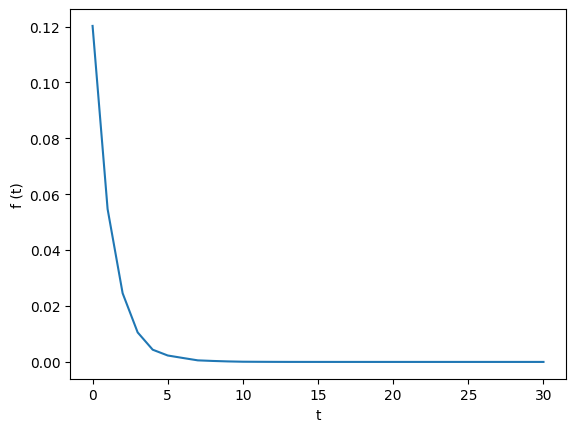
且與的關係大約呈現線性
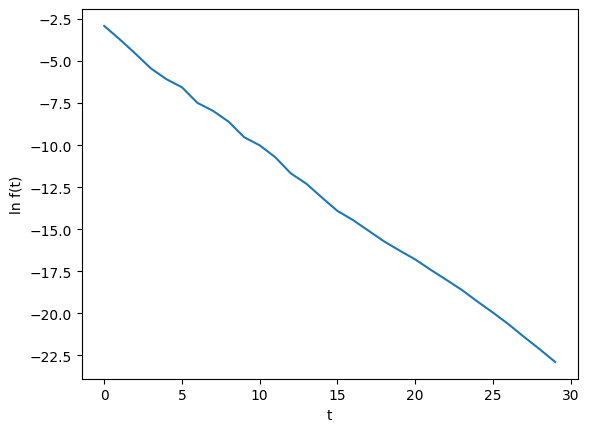
假設滿足線性關係使得,則可解出與,即
而則在2左右波動,滿足前面的假設
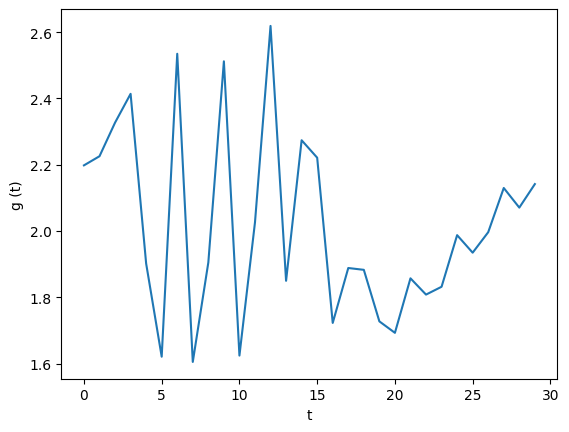
觀察多次實驗,在 與「0.3的隨機參照機率」的條件下多次嘗試
- PR值的誤差逐漸縮小,即
- PR值得誤差量每次約少2倍,即
特別注意,在最開始生成C矩陣的時候,任意頁面參照其他頁面的機率設為0.3,即
我認為收斂速度會被下列因素影響
- 頁面數量,數量越多收斂越慢
- 阻尼係數,不確定影響關係
- 隨機參照機率,不確定影響關係
附件
原始文獻
- BRIN, Sergey; PAGE, Lawrence. The anatomy of a large-scale hypertextual web search engine. Computer networks and ISDN systems, 1998, 30.1-7: 107-117.
Google 的資料
Google搜尋引擎的資料庫收錄超過千億網頁,檔案大小超過100,000,000 GB。
https://www.google.com/search/howsearchworks/how-search-works/organizing-information/
新算法
根據Google前員工的說法,”PageRank自2006年以來就沒有被使用過”,取而代之的新算法是